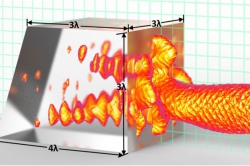Bessel beams have many useful properties. First of all, they are non-diffracting light beams with an infinite number of rings that can cover an infinite distance. Secondly, thanks to their unique physical properties, these beams can “restore” themselves even after meeting an obstacle, for instance when propagating in humid atmosphere.
These properties make Bessel beams attractive for different applications, wireless communications included. In this regard, beams of THz radiation draw the most attention. Why? Point is, terahertz radiation falls in between infrared radiation and microwave radiation, with the terahertz band covering the wavelength range between 0.1–1 mm. The wider the wavelength range, the more channels there are to connect different devices to. This can contribute to enhancing the connection speed of each individual device.

What is more, terahertz radiation is non-ionizing, i.e. harmless to human health (you can read more about ionizing radiation and its effects here), and can penetrate a wide variety of media. Still, the problem is that true non-diffractive Bessel beam can not be created in practice, as generating them would require an infinitely long lens and an infinite amount of energy. So, scientists generate quasi-Bessel beams, focusing Gaussian beam by an axicon or conical lens. The resulting Gauss-Bessel beams have properties as close as possible to those of true non-diffractive Bessel beams.
“Before applying these beams in practice, we have to study their properties. Thus, our research is a comprehensive spatio-temporal and spectral analysis of beam propagation for pulse terahertz radiation. On this stage, we’ve been conducting numerical simulation of the beam’s propagation in vacuum,” explains Maksim Kulya, member of ITMO’s International Institute “Photonics and Optical Information Technology”.
Such a comprehensive study of spatio-temporal and spatio-spectral dynamics of pulsed broadband terahertz Gauss-Bessel beams propagation has never been conducted before. Scientists from ITMO University succeeded in modeling the evolution of electric intensity of a pulsed broadband terahertz Gauss-Bessel beam - the field’s amplitude, spectral properties and some other important indications, - in any point in space along the beam’s propagation.

The modeling was conducted by means of terahertz pulse time-domain holography. This method that is based on classical terahertz time-resolved spectroscopy allows to register two-dimensional distribution of the terahertz field’s complex amplitude, as well as conduct numerical computations of its propagation to an arbitrary plane. This way, it becomes possible to retrace the spatio-temporal evolution of the terahertz field. The method has been previously tested on reconstructing the image and relief of an amplitude-phase object in the 0.1-0.5 THz frequency range.
“We depicted the full spatio-temporal evolution of these beams, and also compared it with the research studies of the previous authors where they looked into the superluminal propagation of terahertz pulses in Bessel beams. As of now, we need to obtain experimental evidence for our results, which is going to be our next step,” concludes Maksim Kulya.
Reference: On terahertz pulsed broadband Gauss-Bessel beam free-space propagation, Maksim S. Kulya, Varvara A. Semenova, Victor G. Bespalov, Nikolay V. Petrov, Scientific Reports, 2018.





